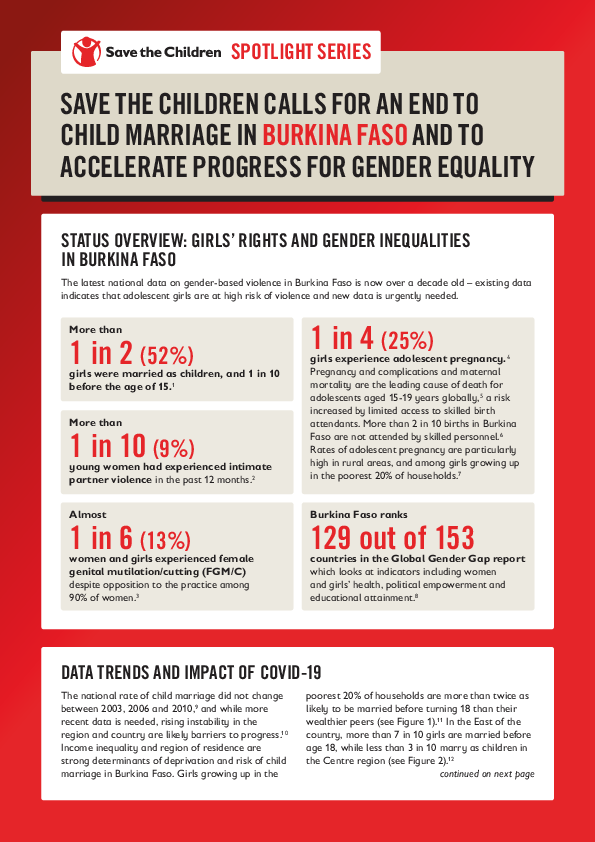
Briefs, Fact Sheets and Brochures
Spotlight Series: Ending child marriage for gender equality
Publication year:
2021
English, French
Format:
PDF (736.2 KiB)
Publisher:
Save the Children International
Gender-based violence against girls: Ending child marriage and accelerating progress for gender equality
Save the Children’s Spotlight series is a collection of country briefings to support national-level advocacy through the latest data and analysis of progress and ongoing barriers. The spotlights seek to include data on drivers, risk factors and consequences of child marriage and other forms of gender-based violence, including data on rates of child marriage, adolescent pregnancy, skilled birth attendance, intimate partner violence, violent discipline and Female Genital Mutilation/Cutting (FGM/C) as well as gender inequality index rankings and the impacts of the COVID-19 crisis to-date. Each makes recommendations to governments based on Save the Children’s national priorities.
__________________
Gender-based violence had reached pandemic proportions long before COVID-19 began to force school closures and lockdowns, push health systems to their breakpoint, and erode protective systems. Worldwide, girls were already disproportionately impacted by this rights abuse and its lifelong and life-threatening impacts. An estimated one in three girls and women experience physical or sexual violence in their lifetimes; 12 million girls marry before their 18th birthday each year, 2 million of which are not yet 15; and at least 200 million girls and women alive today have undergone FGM/C, most before or during adolescence.
Now, UNFPA projects that without urgent action the COVID-19 crisis could set back progress toward the elimination of gender-based violence by one-third, with an additional 13 million girls at risk of child marriage and another 2 million at risk of FGM/C by 2030. Save the Children’s projections suggest that globally, the impacts of COVID-19 in 2020 alone may already have put an additional half a million girls at risk of child marriage, raising the number of girls at risk of child marriage between now and 2025 to 61 million.
The crisis threatens hard won progress. Between 2000-2010 the world saw the steepest decline in child marriage rates since current records began. While much of this progress was driven by reductions in India, important initiatives like gender equality commitments under the Sustainable Development Goals and the AU Campaign to End Child Marriage in Africa have since paved the way for further progress. While these processes and national and community-level advocacy, including that led by women and girls’ organisations have seen important wins, global progress has plateaued in the past decade, with stark inequalities within and between countries. Countries affected by conflict and humanitarian crises remain particularly affected with ten of the twenty countries with the highest rates of child marriage considered fragile or extremely fragile states and twelve experiencing extreme humanitarian crises.
A decade of lost opportunities and the impacts of COVID-19 bring a new urgency to efforts to end child marriage and other forms of gender-based violence and violations of girls’ rights by 2030. The Generation Equality process, which will set the global agenda for gender equality for 2020-2025 was created to accelerate much needed progress through the creation of multisectoral Action Coalitions of champions for women and girls’ rights, to lead the development and implementation of blueprints for delivery. This global process has the potential to be a critical catalyst for change and must support ongoing national and community level efforts, including those led by women and girls’ networks and organisations. Save the Children’s recommends that global commitments to end child marriage and other forms of gender-based violence against girls:
- Make ending child marriage a critical priority under the Generation Equality blueprints with the aim of reducing global rates by 14% by 2025 to put the world on track to meet the SDG target to end this harmful practice by 2030.
- Support the development, funding and implementation of multisectoral national action plans to end child marriage. Plans should bring together ministries of health, education, justice, child protection and finance, women and girl-led organisations and communities including girls themselves. Monitoring mechanisms should be built-in to ensure accountability to girls.
- Improve efforts to address gender-based violence against girls, including child marriage, in humanitarian contexts by:
- equitably funding, desperately underfunded efforts to address gender-based violence in humanitarian responses
- closing data gaps on child marriage and
- making use of the growing body of evidence on what works to end child marriage in humanitarian contexts.
- Raise girls’ voices by supporting their right to safe, inclusive and meaningful participation in all public decision-making. This must include technical and financial support for the establishment of participation mechanisms and flexible funding to girl-led networks and organisations.
- Address the immediate and ongoing risks of gender-based violence exacerbated by COVID-19 through increased technical and financial support for inclusive gender-based violence, prevention, mitigation and response as well as child protection. This must include standalone gender equality programming to address the root cause of gender-based violence and transform harmful gender norms, as well as flexible funding to local women and girls’ organisations.
Read full abstract
Authors
Document information
Publisher
Format
Content type
Country
Topics
Rights
© Author/Publisher
Found a mistake? Help us improve!
If you have noticed a document assigned to the wrong author or any other inaccuracies, let us know! Your feedback helps us keep our data accurate and useful for everyone.
Share
Link
